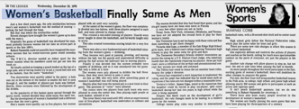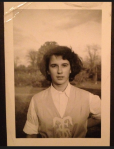Back around the middle of the 20th century, when I played high school basketball, we were not allowed to cross the center line. There were six girls on a team, three forwards and three guards, all rooted in their own half of the court. Guards never took a shot – they couldn’t. They struggled to get the ball from the opposing forwards, then threw it across the line to their own forwards, who got the glory, what there was of it. We were not allowed to dribble – one bounce, that’s all you got – and there was no such thing as a point guard. I went to a small girls’ school with a tradition of (relatively) serious attention to sports: our basketball rivalry with a neighboring school dated all the way back to 1901. But we played by girls’ rules, of course; nobody crossed the center line until 1971, just before Title IX, when all the rules changed.
 I’ve often thought that “Crossing the Center Line” would be a fine title for a memoir for someone who came of age in the 1950s and lived through second-wave feminism in the 70s. In adolescence and beyond, we lived by girls’ rules. Like most people in those days, born too soon for the “Question Authority” t-shirt, we pretty much accepted the rules that were handed down. Most of us didn’t ask why girls and boys played basketball or anything else by different rules, and no one bothered to explain it to us. I gathered from the murky atmosphere around the question that it had something to do with bodies. Ours were strangely vulnerable; there was a vague threat that too much running around might damage our female organs, make us unfit for marriage and maternity. What a great metaphor for mid-century female experience: restricted to half the space available on behalf of imagined potential motherhood!
I’ve often thought that “Crossing the Center Line” would be a fine title for a memoir for someone who came of age in the 1950s and lived through second-wave feminism in the 70s. In adolescence and beyond, we lived by girls’ rules. Like most people in those days, born too soon for the “Question Authority” t-shirt, we pretty much accepted the rules that were handed down. Most of us didn’t ask why girls and boys played basketball or anything else by different rules, and no one bothered to explain it to us. I gathered from the murky atmosphere around the question that it had something to do with bodies. Ours were strangely vulnerable; there was a vague threat that too much running around might damage our female organs, make us unfit for marriage and maternity. What a great metaphor for mid-century female experience: restricted to half the space available on behalf of imagined potential motherhood!
What’s worse, it turned out to be a thoroughly misguided notion. We now know that young women who participate in athletics are less likely than others to smoke, drink, take drugs, or have to deal with an unwanted pregnancy. In later life they are less likely to develop breast cancer or osteoporosis. If you pay  attention to the real world, you have to notice that cheerleading is much more dangerous than basketball: between 1982 and 1997 (when girls used the full court), cheerleading produced 34 fatalities and catastrophic injuries in female players; basketball, only two. But gender rules have little to do with physical reality; they’re about power and place, about keeping women from taking up too much space.
attention to the real world, you have to notice that cheerleading is much more dangerous than basketball: between 1982 and 1997 (when girls used the full court), cheerleading produced 34 fatalities and catastrophic injuries in female players; basketball, only two. But gender rules have little to do with physical reality; they’re about power and place, about keeping women from taking up too much space.
Physiological rationales can be entertaining, though, and sometimes perversely enlightening. To begin with Aristotle, as so many have, “we should look upon the female state as being as it were a deformity, though one which occurs in the ordinary course of nature.” Moving forward a couple of millennia, Dudley Sargent MD* wrote in The Ladies Home Journal in 1912 that sports and exercise tended to broaden shoulders and develop muscles, making “women’s figures more masculine.” It was of even more concern to Sargent that the “mental and moral qualities” that accompanied such physical development were also masculine – qualities like “will, concentration, loyalty, grace, courage, strength and endurance.” Not to worry, though – careful regulation of such physical circumstances as distances run (the full court) and of training programs would prevent such unwelcome development. Women, Sargent opined, cannot stand physical or mental stress: hard training and vigorous competition might help them succeed, but such success would come “at a fearful cost to themselves and eventually to their children.” [*Thanks to Helen Wheelock at Women’s Hoops Blog for the excellent timeline, and the link to Dr. Sargent!]
I guess I was right to suspect that our sports and games were governed by rules enforced by threats to our unborn children, threats proclaimed by Aristotle, Sargent, and many, many more. It was not all about sports and games, of course. In the bloody academic infighting of the 1980s, women who were struggling to cross that center line referred among themselves to the “boys’ rules” and “girls’ rules” that seemed to govern promotion and tenure. For those of us of a certain age, the metaphor works pretty well across the board. We grew up with girls’ rules, fought to break out of them, and now observe and frequently rejoice at the consequences.
In recent years I’ve become a devoted follower of the UConn women’s basketball program and of successive versions of their teams. I’m not alone: UConn has legions of gray-haired fans (known to my elder daughter as “fangrans”) who regularly attend their home games and sometimes even follow the team to the site of the Final Four. I’ve been watching the Connecticut women for more than ten years now, and most of the time I’ve watched them win. They’re incredibly good – fast, strong, smart. It’s a joy to see those muscled young bodies move around the court – running, dribbling, jumping, shooting. It’s a special pleasure to watch one of their gifted point guards – think Sue Bird, Moriah Jefferson, or – now – Crystal Dangerfield! – take a pass from one of the six-footers under the basket and run the length of the gym, finishing her journey with a stylish layup.
Interviewed last summer, after her great season as a Little League pitching star, Mo’ne Davis said she wants to become a point guard at UConn. I’m already looking forward to watching her run the ball down the full court, unrestrained by the center line.
Have you crossed the center line? I’d love to hear from you. Comments welcome, below.



Nice blog thanks forr posting
LikeLike
I was in Jr. High school in 1967 – 1968 in California. There were a couple of players who were allowed to cross the center line. I think they were called the driving forward and the roving guard.
LikeLike
Pingback: P.S. A Weight Room of One’s Own | The Oldest Vocation
Pingback: Is football the harmless pastime it claims to be?
Pingback: Coming of Age in the 1950s All Over Again | The Oldest Vocation
Pingback: P.S.: We’re All Nasty Now | The Oldest Vocation
Thanks! So interesting to hear about some of the consequences of Title IX from someone who experienced them —
LikeLike
I did not know about the “center line” rule! I can’t really even visualize how it would work in a game… What a poignant piece you wrote. I really enjoyed reading it and being reminded of the bat-shit crazy reasoning behind decisions that were made truly not that long ago.
I was able to pitch for Syracuse as a result of Title IX. I am the first every recruit/signee to play there as they phased out the men’s wrestling team. As it turned out, on my recruiting trip, I ended up at the Men’s Wrestling house on campus for a party. When I told them why I was there they kicked me out. I later learned why!
In any case, Title IX and women’s sports have a long way to go but certainly come a long way thanks to women like you – I’m grateful to have earned a better education than I could have afforded otherwise in addition to lifelong friends and everything else that comes with being a part of a sport/team.
LikeLike
This is a great metaphor and one that resonates for me even though I was playing sports post-Title IX. I grew up in Iowa and had to play girls rules even in the early 80s. I guess it was marginally better; at least we got two dribbles before we had to pass. Still, it reminds me of the ways my environment, even though it was supposed to be more liberal, still constrained me. I’m still trying to master the art of the full court fast break.
Thanks for writing. I was a student of yours in the 90s and I stumbled across this post while searching for something else.
LikeLiked by 1 person
What a wonderful comment! thank you…
LikeLike
I stopped watching men’s basketball years ago: too much body contact. If basketball were more chaste it would become more graceful, still fast, and supercharged like the best poetry, ever testing the limits of form and meter. Like women’s basketball at UConn. Atkinson, you are a superior point guard. Get back in there.
LikeLike
Awesome article. I cannot wait to share with my PE students at my all-girl school,,
LikeLike
Thanks Eileen. Let me know what they have to say about it!
LikeLike
What a great metaphor–crossing the center line–and what a lot of reality it fits! Sadly there are so many lines one still is punished for crossing, but joyfully there are so many more now that simply are not marked, so one runs over them with hardly a side glance or even with unsuspecting glee. Thanks for the story. It makes me smile.
LikeLike
What a wonderful essay. It takes me right back to those days of overt “girls’ rules,” when the center line was EVERYWHERE. And now we’re all rooting for the UConn Women’s Basketball Team. It’s great to have such a vivid image to remind us that though too little has changed, and far too slowly–still, things HAVE changed, and for the better. Atkinson just has a way of getting to the heart of the matter, with wit and style.
LikeLiked by 1 person
Love the perspective. It is so Important that we remember.
LikeLike